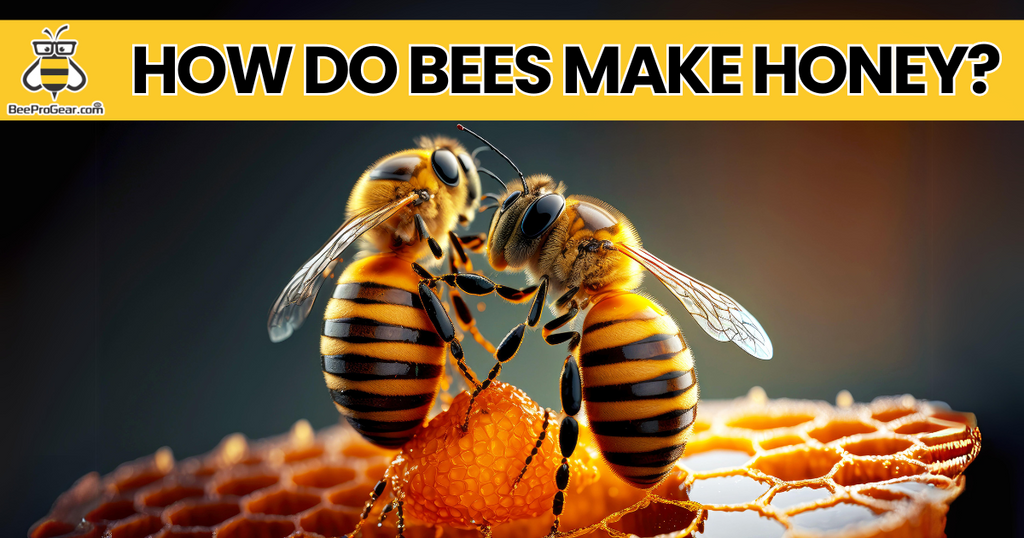Bees make honey through a fascinating process of collecting nectar from flowers, storing it in their hives, and transforming it into honey through enzymatic action and evaporation. This liquid gold serves as their primary food source and provides essential nutrients for the entire colony. Here's a step-by-step explanation:
-
Gathering Nectar: Bees fly around looking for flowers. They use their long tongues to suck up sweet liquid called nectar from inside flowers.
-
Storing Nectar: Bees keep the nectar in a special stomach while they fly back to their hive.
-
Sharing Nectar: When they get back to the hive, bees pass the nectar to other bees by spitting it out into their mouths.
-
Making Honey: Bees put the nectar into small wax cells in the hive. They fan their wings to dry out the nectar, turning it into thick honey.
-
Closing Cells: Once the honey is ready, bees seal the cells with wax to keep it safe.
-
Saving for Later: Bees keep the honey in the hive as food. They eat it when they need energy, especially during winter when flowers aren't blooming.
Why do bees make honey?
Bees make honey for a few important reasons:
-
Food Source: Honey serves as the primary food source for bees, especially during times when flowers aren't blooming or when nectar is scarce. Bees store honey in their hives to eat later when they need energy.
-
Energy Reserve: Honey is packed with sugars, which are a concentrated form of energy. By converting nectar into honey, bees create a long-lasting and easily accessible energy reserve that can sustain them through periods of low food availability, such as winter.
-
Survival of the Colony: Bees work together as a colony to ensure their survival. Making honey is a vital part of this teamwork. By collecting and storing honey, bees ensure that there's always enough food to support the entire colony, including the queen, worker bees, and developing larvae.
-
Regulation of Temperature: Honey also plays a role in regulating the temperature inside the hive. Since honey is thick and viscous, it can help insulate the hive, keeping it warm during colder weather and cool during hot weather. This temperature regulation is crucial for maintaining the health and well-being of the bee colony.
What is honey made of?
Honey is made up of a combination of several key components:
-
Sugars: The primary sugars found in honey are glucose and fructose. These sugars make honey sweet and provide bees with a concentrated source of energy.
-
Water: When bees collect nectar from flowers, it contains a high percentage of water. During the process of making honey, bees evaporate much of this water, but some still remains in the final product.
-
Enzymes: Bees add enzymes to the nectar they collect, which helps break down complex sugars into simpler sugars and aids in the digestion of honey by both bees and humans.
-
Acids: Honey contains small amounts of acids, such as gluconic acid and acetic acid, which contribute to its flavor and help prevent the growth of bacteria and fungi.
-
Minerals: Honey contains trace amounts of minerals, including calcium, potassium, magnesium, and phosphorus, which are derived from the nectar of flowers.
-
Amino Acids: Honey contains small amounts of amino acids, the building blocks of proteins, which are essential for various metabolic processes in bees and can contribute to the nutritional value of honey for humans.
-
Vitamins and Antioxidants: While honey is not a significant source of vitamins, it does contain small amounts of vitamins such as vitamin C, as well as antioxidants, which can help protect cells from damage caused by free radicals.
This is the answer to the question many people asked that what do bees use to make honey?
What do bees do with honey?
Absolutely, honey is indeed the primary food source for bees, essential for their survival and well-being throughout the year. It's fascinating how bees work together to produce and store honey, ensuring they have enough to sustain themselves, especially during times of scarcity like winter or bad weather. Their remarkable teamwork and industrious efforts remind us of the intricate balance of nature and the interconnectedness of all living things. So, the next time we enjoy the delicious sweetness of honey, it's worth taking a moment to appreciate the hard work and collaboration of these incredible insects.
Sweet honey facts
Sure, here are the rewritten statements:
- On average, a single bee produces approximately one twelfth of a teaspoon, which is about 0.8 grams, of honey over her lifetime.
- It takes an incredible 2 million visits to flowers by honeybees for a colony to yield just half a kilogram, or about one pound, of honey.
- Honey exhibits a wide range of colors, varying from nearly transparent to deeply dark, showcasing its diverse appearance.
- Just as diverse as the colors, honey also offers a multitude of flavors, reflecting the wide array of flowering plants available for bees to gather nectar from.
- Honey possesses remarkable properties including antibacterial, anti-inflammatory, and probiotic qualities, making it a beneficial substance for health and well-being. When stored properly, honey remains indefinitely without spoiling.
Do Bees eat their own Honey:
Yes, bees eat their own honey. Honey is their main food source, providing them with energy and nutrients. They eat it when they can't find nectar from flowers, like during winter or bad weather. They also feed it to baby bees and use it to stay healthy.
Do All Bees make Honey?
Only honey bees make honey by collecting nectar, storing it, and transforming it into honey inside their hives. Other bees, like bumblebees and stingless bees, also collect nectar but don't have the same process for making honey. They store nectar differently in their nests for food.
